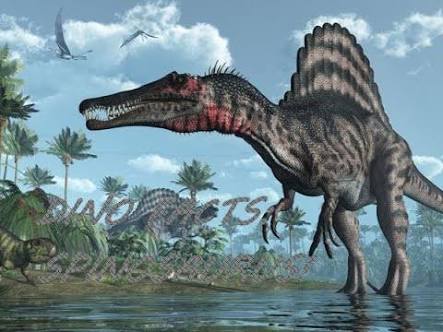Carnivores Dinosaurs
SPINOSAURUS
.jpg)
Spinosaurus (meaning "spine lizard") may be a genus of saurischian dinosaur that lived in what now could be geographic region, throughout the higher Albian to higher Turonian stages of the geological period, regarding 112 to ninety three.5 million years agone. This genus was known initial from Egyptian remains discovered in 1912 and represented by German fossilist painter Stromer in 1915. the first remains were destroyed in warfare II, however further material has return to lightweight in recent years. it's unclear whether or not one or 2 species area unit drawn within the fossils reported within the scientific literature. the simplest known species is S. aegyptiacus from Egypt, though a possible second
Spinosaurus was among the most important of all well-known carnivorous dinosaurs, nearly as giant or perhaps larger than tyrannosaur, Giganotosaurus and Carcharodontosaurus. Estimates revealed in 2005, 2007, and 2008 instructed that it absolutely was between twelve.6–18 metres (41–59 ft) long and seven to twenty.9 tonnes (7.7 to 23.0 short tons) in weight.[1][2][3] a replacement estimate revealed in 2014 and supported a a lot of complete specimen, supported the sooner analysis, finding that Spinosaurus might reach lengths of over fifteen m (49 ft).[4] The os of Spinosaurus was long and slim, just like that of a contemporary crocodilian reptile. Spinosaurus is understood to possess eaten fish, and most scientists believe that it afraid each terrestrial and aquatic prey; proof suggests that it lived each ashore and in water as a contemporary crocodilian reptile will. The distinctive spines of Spinosaurus, that were long extensions of the vertebrae, grew to a minimum of one.65 meters (5.4 ft) long and were possible to possess had skin connecting them, forming a sail-like structure, though some authors[by whom?] have instructed that the spines were lined in fat and fashioned a hump. Multiple functions are advance for this structure, together with thermoregulation and show.
GIGANOTOSAURUS
.jpg)
Giganotosaurus could be a genus of saurischian that lived in what's currently Argentina, throughout the first Cenomanian age of the Late Cretaceous period, about ninety eight to ninety seven million years past. The type specimen specimen was discovered within the Candeleros Formation of geographical area in 1993, and is nearly seventieth complete. The animal was named G. carolinii in 1995; the genus name interprets as "giant southern lizard" and also the specific name honours the discoverer, Rubén D. Carolini. A dentary bone, a tooth and a few tracks, discovered before the type specimen, were later appointed to the current animal. The genus attracted a lot of interest and have become a part of a scientific dialogue regarding the most sizes of saurischian.
Giganotosaurus was one in every of the biggest proverbial terrestrial carnivores, however the precise size has been onerous to work out thanks to the unity of the remains found to date. Estimates for the foremost complete specimen vary from a length of twelve to thirteen m (39 to forty three ft), a skull 1.53 to 1.80 m (5.0 to 5.9 ft) long, and a weight of four.2 to 13.8 t (4.6 to 15.2 short tons). The dentary bone that belonged to a purportedly larger individual has been wont to extrapolate a length of thirteen.2 m (43 ft). Some researchers have found the animal to be larger than theropod dinosaur, that has traditionally been thought of the biggest saurischian, whereas others have found them to be equal in size, and therefore the largest size estimates for Giganotosaurus exaggerated. The os was low, with unsmooth (rough and wrinkled) nasal bones and a ridge-like crest on the os before of the attention. The front of the jaw was planar , and had a down sticking method (or "chin") at the tip. The teeth were compressed sideways and had serrations. The neck was robust and therefore the girdle proportionately tiny.